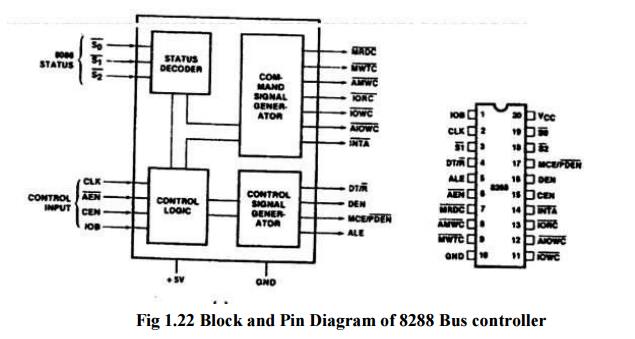Chapter: Microprocessor and Microcontroller : 8085 and 8086 Microprocessor
I/O Ports and Data Transfer Concepts
I/O Ports
There are
two methods in which I/O devices can be connected to the Microprocessor.
ü Memory
mapped I/O
ü I/O
mapped I/O
Memory mapped I/O:
In this method I/O device is treated like the memory. Here there is no
IO/M signal. If the processor wants to read the data from a I/O device it will
place the address of the I/O device on the address bus. Then the I/O device
will get selected. The memory which is having the same address will also get
selected.so we have to use separate address for memory and separate address for
I/O device.
I/O mapped I/O:
Here we have the IO/M signal. So we can select either the memory or I/O
device for read and write operation.
Data Transfer Concepts
ü Parallel
data transfer
ü Serial
data transfer
I. Parallel data transfer
ü Programmed
I/O
ü Interrupt
I/O
ü DMA
Programmed
I/O:
Here the
processor has to check whether the I/O device is ready or not through the Ready
signal of the I/O device. If the ready signal is high then it will send the
data to the I/O device. Otherwise it will continuously check the Ready signal.
The processor is busy in checking the Ready signal. The drawback is wastage of
time.
Interrupt
I/O:
In this
method the I/O device will interrupt the Processor through the INTR signal to
indicate to the processor that it is ready to accept the next data. Then the
processor will send the INTA signal. Then the processor stops its normal
execution and start transferring the data to the I/O device.
DMA:
Using DMA
I/O device can directly transfer the data to the Memory using the Address and
Data buses of Processor.
II. Serial data Transfer
Some of
the external I/0 devices receive only the serial data. Normally serial
communication is used in the MultiProcessor environment. 8051 has two pins for
serial communication.
ü SID-
Serial Input data.
ü SOD-Serial
Output data.
Interrupts
The
processor has the following interrupts:
INTR is a
maskable hardware interrupt. The interrupt can be enabled/disabled using
STI/CLI instructions or using more
complicated method of updating the FLAGS register with the help of the POPF
instruction.
When an
interrupt occurs, the processor stores FLAGS register into stack, disables
further interrupts, fetches from the bus one byte representing interrupt type,
and jumps to interrupt processing routine address of which is stored in
location 4 * <interrupt type>. Interrupt processing routine should return
with the IRET instruction.
NMI is a non-maskable interrupt.
Interrupt is processed in the same way as the INTR interrupt. Interrupt type of the NMI is 2, i.e. the address
of the NMI processing routine is stored in location 0008h. This interrupt has higher
priority then the maskable interrupt.
Software interrupts can be
caused by:
ü INT
instruction - breakpoint interrupt. This is a type 3 interrupt.
ü INT
<interrupt number> instruction - any one interrupt from available 256
interrupts.
ü INTO
instruction - interrupt on overflow
ü Single-step
interrupt - generated if the TF flag is set. This is a type 1 interrupt. When
the CPU processes this interrupt it clears TF flag before calling the interrupt
processing routine.
Processor exceptions: Divide
Error (Type 0), Unused Opcode (type 6) and Escape opcode (type 7).

Related Topics